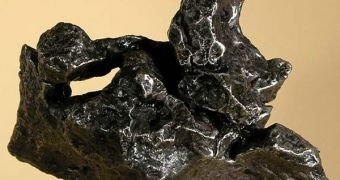On Sunday, many people in Texas were scared by what appeared to be falling stars in the night sky. Some said that they came from UFOs, while others maintained that they were a part of the cloud of debris generated by the collision of two satellites high above the Earth. However, astronomers argued this week that the lights most likely came from meteor fragments entering the planet's atmosphere. Now, experts at the University of North Texas believe they may have found two meteor samples to back up their claims.
“It's black like charcoal. Underneath this crust the color of the rock is concrete like gray,” Ron DiLulio, UNT director of the planetarium and astronomy lab program, announces. “We did a lot of pre-planning. We looked at the angles of what they saw in the sky and we were able to map it all out. We put a plan together and we drove around small country roads. Texas has lots of small farm to market roads,” UNT's observatory manager Preston Starr adds.
The researchers took the supposed samples from the small field where they were found, and placed them in ZipLock bags, to prevent further contamination. They plan to take them back to their laboratory for further analysis. The two also reveal that they have met with many people in the area, all looking for the fragments. Among them there was “a commercial meteorite hunter, and we wanted to get there so we could have it first for science,” DiLulio shares.
“We feel that there are probably several hundred pieces. What happens when these things fall – they may break apart. We want to find these early and study the primitive material before our atmosphere affects them. Every time we find one, we mark where it is on the map and we can measure how much material actually hit the surface of the Earth,” he points out.
The team is sure that there are larger pieces of meteor still to be found in the region, and have extended their efforts of locating them. They have to recover the stones as quickly as possible, before prolonged exposure to Earth's atmosphere affects their inner structure and makes them lose important geological data as to the origins and age of the meteor. The two also want to determine the size it had before entering the atmosphere.

 14 DAY TRIAL //
14 DAY TRIAL //